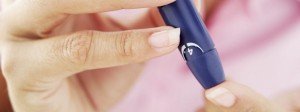Diabetes mellitus is the most common form of diabetes and is an international health concern. It is on the rise as more and more people are being diagnosed with the condition.
However, just because it is common, doesn’t mean it can be under estimated. There can be serious health issues from both high blood glucose levels and low blood glucose.
Diabetes Mellitus
Diabetes mellitus is when the body cannot produce enough insulin the regulate blood sugar levels, or the insulin cannot be used properly by the bodies cells. This means blood sugar (glucose) levels gradually increase and cause hyperglycaemia.
Depending on the severity of the condition, patients control their blood sugar with diet, oral medication or insulin injections. Too much medication or too little sugar can cause hypoglycaemia, which is low blood sugar levels.
St Mark James First Aid manual advises if you are in any doubt as to whether the patient has hypo or hyperglycaemia then give sugar, this will correct hypoglycaemia, and will do little further damage in hyperglycaemia.
Both hyperglycaemia and hypoglycaemia are medical emergencies.
Hyperglycaemia
If hyperglycaemia is maintained over a prolonged amount of time, the patient can become unconscious. However, this progression is slow and can be over a few days.
The symptoms of hyperglycaemia are identified in St Mark James First Aid manual by:
- warm, dry skin
- rapid pulse
- rapid breathing
- fruity/sweet breath (often described as pear drops)
- excessive thirst
If hyperglycaemia is untreated, it will eventually lead to drowsiness and then unconsciousness. Hospital treatment is needed in order to get the patients blood sugar back down into a normal and safe range and it is your role as a first aider to arrange transfer to hospital.
Side Effects of Hyperglycaemia
Poor diabetes control can be very detrimental. Continued hyperglycaemia results in a number of consequences, the most serious being ketoacidosis. This is a condition where the body doesn’t have insulin, and therefore can’t use glucose for energy. It therefore uses its fat stores instead. The waste product created from this is ketones, which are normally excreted in the urine. If the ketone levels get too high, the body can’t get rid of all of them, therefore they build up in the blood and create ketoacidosis.
Symptoms of Ketoacidosis:
- Shortness of breath
- Fruity smelling breath
- Nausea and vomiting
- Very dry mouth
Hypoglycaemia
Hypoglycaemia is when the blood sugar level falls below the normal level. This will affect the function of the brain and can also lead to unconsciousness. First Aid Classes teach you that the effects of hypoglycaemia develop rapidly.
Symptoms of Hypoglycaemia are recognised by:
- History – patient may recognise the feeling/symptoms of an oncoming hypo
- Weakness, faintness or hunger
- Palpitations and muscle tremors
- Strange actions or behaviour, may seem confused or aggressive
- Sweating and cold, clammy skin
- Rapid and strong pulse
- Deteriorating responsiveness
As a first aider you must quickly raise the patients blood sugar level. Many diabetic patients are aware of their condition and will carry a form of sugar or glucose tablets or gel for such emergencies.
St Mark James First Aid manual tells you to assist the patient to sit down or lay down. Give them a sugary drink or snack if available or assist them to take any sugar lumps or glucose tablets or gel they may have. These sugary supplements will rapidly get sugar absorbed into the blood and will raise their glucose levels.
If the hypo is in an advanced stage, it will impair the consciousness of the patient and 
An unconscious patient should always be placed into the recovery position to protect their airway. Always continually monitor their responsiveness, airway, breathing and pulse and be ready to give CPR if necessary.
Side Effects of Consistent Hypoglycaemia
Patients who continually have hypoglycaemic episodes, will become ‘unaware’ to the condition, and will not notice the symptoms that tell them their blood sugar levels are low. This is because their body gets used to being low and this is how they can be caught out unprepared.
REFERENCES
First Aid Manual (The Authorised Manual of St. John Ambulance, St Andrew’s Ambulance Association and the British workplace approved), 2006.
American Diabetes Association, http://www.diabetes.org/living-with-diabetes/treatment-and-care/blood-glucose-control/hyperglycemia.html
